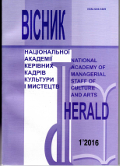METHODOLOGICAL PROBLEMS OF THE CODE AND "DOUBLE CODING" ANALYSIS IN THE CONTEXT OF SEMIOTICS, STRUCTURALISM AND POST- STRUCTURALISM
DOI:
https://doi.org/10.32461/2226-3209.1.2016.138481Keywords:
cultural code, "double coding" in the art, the sign code, a speech code,Abstract
The research of the most important methodological aspects of cultural codes and the "double coding" in the artsrequires the development of adequate and effective conceptual apparatus. Without it, it is impossible to penetrate the essence of the problem, analyze its main aspects and trends of solutions. The need to learn the basic concepts that revealthe specifics of cultural codes and the "double coding" in the art due to the fact that in the content of these definitionsdetermined by the strategy of theoretical research, the research direction of movement of thought. We must alsobear in mind the fact that, in determining the essential concepts as categories, except for decisions purely instrumentalobjectives defined by the basic outlines of the problem field of study problems, their relationship with other philosophical,aesthetic, cultural and artistic issues and related concepts.
Problems of cultural codes and the "double coding" in art are very wide, associated with them issues related tothe fundamental relationship in the "culture-art-work-practice". There is nothing surprising about the fact that art, spiritualpractice and being there next to each other and is a significant part of the culture. In the analysis of the reality of art eachtime it is clearly shown that for certain socio-aesthetic forms of interaction with other social phenomena, it can’t exist. Onthe other hand, in the context of clarifying methodological and philosophical and aesthetic problems of the analysis ofcodes of culture and "double coding" in the arts important are the practical effect of the double standards to the realitiesof life and art. Therefore, in this study, the problem of cultural codes and the "double coding" in the art will determinewithin a holistic understanding of culture.
Codes culture is often seen as an intrinsic property of the artistic culture, sometimes the focus is on codelanguagefeatures imagery in various art forms. The essence of codes of culture consists of separate symbols, signs,pictures, images, ideas, which at first sight independent of one another, and in fact interrelated and mutually deterministic(clear and unambiguous) in the same associative field (Roland Barthes). From a more general point of view of culturalcodes are the sign and symbol integrity (visual, iconic, auditory) and the semantics of the content (ideas, emotions, color sound, movement, etc.). Each of the semiotic and semantic elements of cultural codes play an important and constructiverole in cooperation with other conveys the meaning of the code.
Code in the culture and its specific form and content, semiotic and semantic transformation occur in the codingprocess (preservation and transmission of information). Such a process typically can occur within a certain historical timeand in a cultural space. The encoding process goes through various stages of development and code acquires newqualities. Here there is a process that can be called a "double-coded" in the art that Charles Jencks described as "playingwith semantics and metaphors". Code of culture in the process of artistic creation concentrates artistic achievements andexperiences, and in particular the art of code gets emotional expressiveness and aesthetic value.
The idea of double coding in this case coincides with a double treatment of signs. In different historical and culturalcontexts of conditionality word mark a new (or additional) value is considered and it is the basis of "double coding". Therefore, itis possible and necessary to use the semiotic approach to the study of phenomena and the code of "double coding" in the historyof culture. Therefore, semiotics is the basis not only of the theory of culture, but any methodology of cultural studies ascultural studies is the product of self-reflection and self-description of the culture, that is meta-semiotic system.
Cultural codesoperate as signs of signs, creating texts about texts, and that is a kind of meta-text, based on semiotics of sign systems.In analysis of the code, and "double coding" in the context of semiotics, structuralism and post-structuralism, wecan distinguish the basic methodological foundations for the study of these problems. Structuralist and poststructuralistanalysis can reveal the concept of "cultural code" through the dual nature of structural relations (oppositions), the opposition,the sign (language) expression meaning. Analyzing the texts of prominent semiotics, structuralist, poststructuralistscientists, we conclude that getting into any kind of art, cultural code can be converted from one form to another, andwhen changing its structure and the direction it goes from one level to the semiotic coding the other, and here there is aprocess of "double coding". Then a new system of values, images, signs, symbols needs a new logic of the opening ofthe "code." Culture Code was in the process of processing, interpretation, reinterpretation, reconstruction, connotations,etc. and it is the subject of research in the postmodern cultural studies and art history.
Downloads
Published
Issue
Section
License
Authors who publish with this journal agree to the following terms:
1. Authors retain copyright and grant the journal right of first publication with the work simultaneously licensed under a Creative Commons Attribution License International CC-BY that allows others to share the work with an acknowledgement of the work's authorship and initial publication in this journal.
2. Authors are able to enter into separate, additional contractual arrangements for the non-exclusive distribution of the journal's published version of the work (e.g., post it to an institutional repository or publish it in a book), with an acknowledgement of its initial publication in this journal.
3. Authors are permitted and encouraged to post their work online (e.g., in institutional repositories or on their website) prior to and during the submission process, as it can lead to productive exchanges, as well as earlier and greater citation of published work (See The Effect of Open Access).


